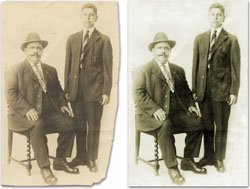Image Selection
| While most problems can be repaired, not every problem is worth trying to fix. Most photographers shoot many exposures of a subject, so they are willing to discard several that they are unhappy with. It is best to repair images that are close to their desired state; otherwise, you may spend too much time on a project (which could send it over budget, in the professional world). Working with Modern ImagesThe most common problems in modern photos are color or exposure issues (both of which we addressed in detail in Chapter 10, "Color Correction and Enhancement"). However, modern photos can still suffer physical damage. If the print is wrinkled or creased, it's always best to use the original source (either a print or the negative). If the print is dusty or smudged, gently wipe it with a soft cloth, and then try to scan or rescan it. If rescanning or reprinting is not an option (or there are issues with a digital photo), you can attempt to fix several problems within Photoshop. This picture was straightened, color corrected, and had missing areas filled in through cloning and healing. Working with Historical ImagesHistorical photos often have more problems than modern photos. There is a much greater likelihood of physical damage. You may have to repair creases, tears, water damage, or adhesive stains (from scrapbooks). It's likely that the photos will have faded and need a boost in contrast or toning. It is generally easier to remove color from a historical source while repairing it. The color can then be added back in during the final stages as an overlay or sepia tone. |
EAN: 2147483647
Pages: 129

